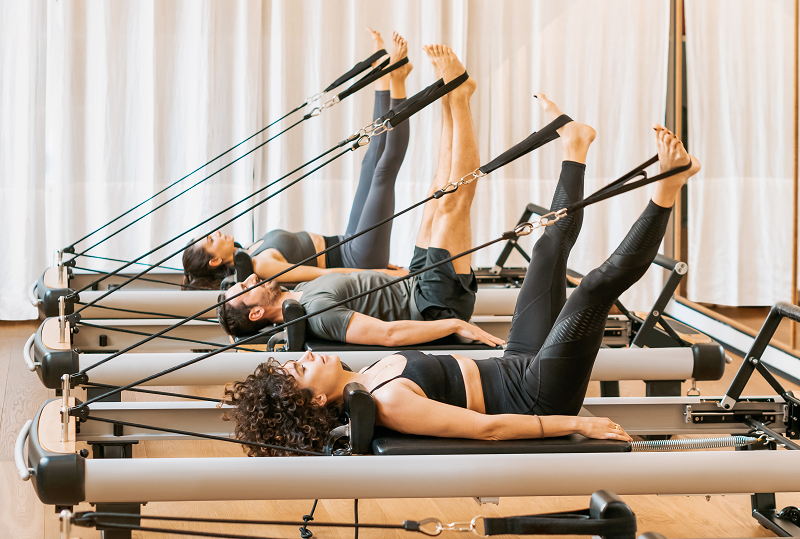There’s no denying that technology has become an integral part of daily life, and the health and wellness sector is no exception. While some might have reservations about society’s growing reliance on tech, its benefits are undeniable. From streamlining business operations to providing educational support and enhancing medical breakthroughs, technology is reshaping how we approach health and wellness, offering new opportunities for personalized care, improved outcomes, and greater accessibility.
If your gym, health club, or fitness center isn’t integrating technology into its offerings and management operations, you’re missing out on valuable revenue streams and leaving pivotal growth opportunities on the table. According to Statista, nearly half of Americans use virtual workouts and other digital solutions. The same report found that that the number of digital fitness customers in the U.S. grew from 63 million in 2018 to 145 million in 2023—an increase of 130 percent in just five years—and the digital fitness industry market size in the United States will reach $20.87 billion in 2024.
The rise of virtual and digital fitness doesn’t have to be a threat to your in-person facility. In fact, by embracing consumer trends and incorporating innovative technologies, you can enhance the member experience and drive growth. Here are 10 fitness-related tech trends to explore for your gym, fitness center, or health club.
Tech-Powered Workouts: Enhancing the Member Experience
1. Interactive Equipment
Ever since Peloton exploded onto the fitness scene in 2012, interactive fitness equipment has remained at the forefront of consumer demand. So much so that Verified Market Research reports that the interactive fitness market is slated to reach $4.8 billion by 2031. Interactive equipment can significantly enhance the member experience. For example, Worklife Wellbeing, a Chicago-based facility managed by Arch Amenities, offers members access to innovative technology from DariMotion, InBody, and MyZone which provide personalized feedback, track progress, and make workouts more engaging. DariMotion analyzes form and provides real-time corrections, while InBody offers detailed body composition analysis. By incorporating such technology, gyms can offer a more customized and effective workout experience, keeping members motivated and engaged.
2. Recovery Tools
Recovery continues to take precedence for fitness consumers. Mindbody reports that post-workout recovery is a priority for nearly half of all Americans, and fortunately, there are numerous tech options to assist in enhancing the recovery process. Worldgate Athletic Club and Spa, an Arch Amenities facility in Herndon, VA, offers members the opportunity to enhance their recovery with advanced technology from HydroMassage and CryoLounge+ with chairs that utilize water, temperature, and muscle stimulation to improve circulation, reduce soreness, and prevent stiffness.
3. Wearable Tech
Wearable technology was the top 2024 trend prediction from the American College of Sports Medicine, and for good reason: Fortune Business Insights reports the global market for fitness trackers is projected to reach $114 billion in 2028. Wearable tech can be anything from fitness trackers like Fitbit and Garmin, to heart rate monitors from Polar and Suunto, or smartwatches from Samsung, Google, and Apple that can do both. Wearable fitness technology offers numerous benefits for both consumers and gym facilities. For individuals, these devices provide personalized data, motivation, and accountability, helping them achieve their fitness goals. And by integrating these tools with gym equipment and software, facilities can create a more engaging member experience.
4. Virtual Reality Workouts
Virtual reality (VR) workouts have gained significant popularity, with an estimated 1-2 million people exercising in VR monthly. Many VR fitness apps incorporate gamification, adding fun and competitive elements to encourage users to achieve their fitness goals. While gyms offer traditional workout experiences, VR can provide unique and immersive environments that are difficult to replicate in a physical setting. To capitalize on this trend, many health clubs are integrating gamification into group fitness classes and offering VR experiences. This not only keeps members engaged but also provides them with the opportunity to try new and exciting workouts without the commitment of purchasing their own VR equipment.
5. AI-Powered Personal Training
While any fitness buff knows nothing can beat in-person personal training, training powered by artificial intelligence (AI) provides a unique solution to those who prefer to work out alone but still require expert guidance or are looking for a less expensive alternative to a private personal trainer. By analyzing individual fitness data and goals, AI can create tailored workout plans, provide real-time feedback, and offer motivation. For gyms, AI-powered training can be a cost-effective way to provide personalized support to members while reducing staffing needs. Additionally, offering AI training as a premium service can generate additional revenue.
Tech-Powered Management: Optimizing Gym Operations
Cloud Based Management Software
A quality gym management software is an essential tool for modern fitness facilities. From membership management and scheduling to financial tracking and marketing automation, these software solutions can significantly enhance the day-to-day operations of a gym, health club, or fitness center. A comprehensive solution like Mindbody, an Arch Amenities Group partner, offers features such as online booking, class scheduling, and payment processing to streamline operations and improve the overall member experience. Many softwares even provide actionable insights by tracking usage patterns like peak hours, preferred equipment, popular classes, and retail purchases. This data can help facilities optimize offerings and cater to member needs. Utilizing a management software is imperative to freeing up your time, streamlining operations, enhancing member engagement, and ultimately increasing revenue.
Data Driven Insights and Programming
Data analytics is a powerful tool for fitness facilities, providing valuable insights into member behavior and preferences. By analyzing data from various sources, such as membership records, attendance logs, and wearable technology, gyms can identify trends, optimize operations, and improve member retention. Profiles by Arch, a first of its kind, data-driven insights tool from Arch Amenities Group, pairs current mobility data with Experian Mosaic® segmentation to anticipate the behaviors, attitudes, and preferences of club members so fitness facilities can create compelling and targeted programming designed to engage their specific population. By leveraging data analytics and tools like Profiles by Arch, gyms can gain a competitive edge and deliver exceptional value to their members.
Mobile Apps
Fitness management apps offer a range of features to streamline operations, improve member engagement, and provide valuable data insights. These apps can be used to manage scheduling, memberships, payments, and communication with members. Through a partnership with ABC Fitness, Arch Amenities offers its facilities access to Exceed by ArchDigital, a comprehensive fitness and wellness platform with a uniquely balanced approach to living well through movement, nutrition, recovery, and self-care. Users can take advantage of coaching from virtual personal trainers, curated wellness and recovery programs, on-demand group fitness classes, and in-app monitoring of metrics and measurements to track progress made. By offering apps to club members, gyms can create a more personalized and engaging experience while also improving operational efficiency and gaining valuable insights.
RFID Technology
RFID (Radio Frequency Identification) technology offers a versatile solution for fitness facilities, addressing concerns around security, member experience, and operational efficiency. By using RFID cards, key fobs or wristbands, members can gain access to various areas of the club including locker rooms (and the lockers within them), the pool, and daycare facilities while restricting access to managerial offices and other restricted areas. RFID can streamline check-in processes, allowing members to quickly and easily enter the facility and can also be used for retail purchases, creating a seamless and convenient experience. Through RFID, fitness facilities can enhance security, reduce wait times, improve member satisfaction, and collect valuable data to optimize operations.
Interactive Kiosks
Interactive kiosks offer a convenient and efficient way for members to access information and services, streamlining operations and enhancing the member experience. These self-service stations can be used to book classes, purchase memberships, access personal data, and even purchase products. When not in use by club members, digital kiosks can be used to display class schedules and updates, promote onsite events or seasonal campaigns, or even highlight club member achievements. By implementing interactive kiosks, fitness facilities can reduce wait times, improve member satisfaction, collect valuable data, and increase revenue.
The Future of Fitness Technology
The fitness industry is undergoing a rapid transformation, driven by the integration of innovative technologies for personalization, efficiency, and engagement. As the industry continues to evolve, we can expect to see even more exciting advancements that will further enhance the member experience and streamline operations. By embracing these technological advancements, fitness facilities can position themselves for long-term success and stay ahead of the competition.





